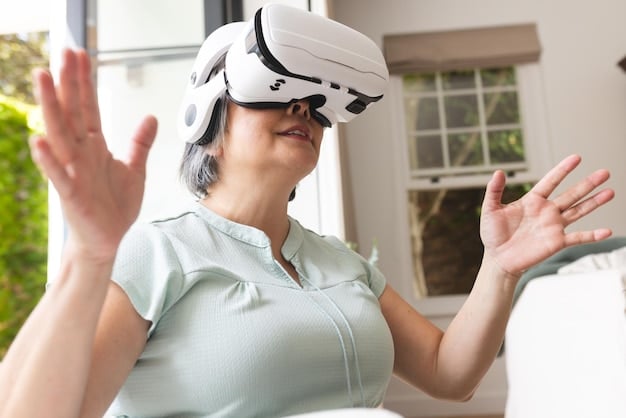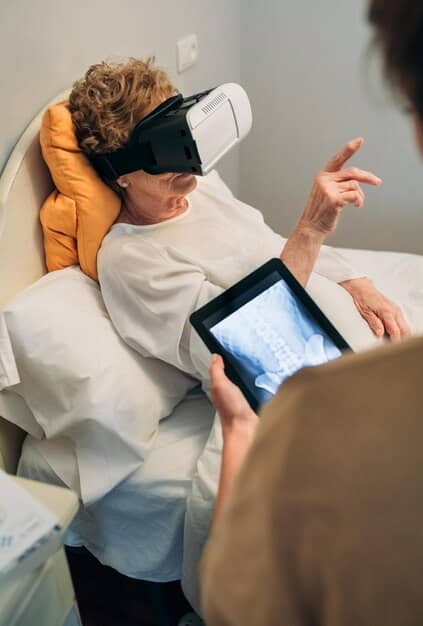How Virtual Reality is Transforming Pain Management and Rehabilitation in US Hospitals

Virtual reality is revolutionizing pain management and rehabilitation in US hospitals by offering immersive, non-pharmacological interventions that effectively reduce discomfort, enhance therapeutic engagement, and accelerate patient recovery processes across various medical disciplines.
The landscape of healthcare is constantly evolving, with groundbreaking technologies emerging to redefine patient care. Among these, virtual reality is transforming pain management and rehabilitation in US hospitals, offering innovative solutions that move beyond traditional approaches. This immersive technology provides patients with compelling alternatives for coping with discomfort and engaging more effectively in their recovery journey, setting a new standard for therapeutic interventions across the nation.
The Science Behind VR’s Therapeutic Power
Understanding how virtual reality exerts its therapeutic effects requires delving into the neuroscience of perception, attention, and pain. VR’s ability to create highly immersive, multisensory experiences can powerfully distract the brain from pain signals.
This distraction isn’t merely a superficial diversion; it leverages complex neurological pathways to alter the brain’s processing of pain. When immersed in a virtual environment, the brain allocates significant cognitive resources to processing the novel visual, auditory, and sometimes haptic stimuli, effectively diminishing the capacity to process noxious inputs from the body.
Cognitive Distraction and Sensory Overload
One primary mechanism is cognitive distraction. By drawing a patient’s attention away from their pain, VR can reduce the perceived intensity and unpleasantness of painful sensations. This is particularly effective during acute pain episodes or during procedures that are typically uncomfortable.
- Attention Redirection: VR captures and redirects a patient’s focus away from pain triggers.
- Sensory Immersion: The rich, multisensory input from VR environments overloads pain processing centers.
- Reduced Anxiety: Immersive experiences often lower pre-procedural and chronic pain-related anxiety.
- Enhanced Coping: Patients learn new coping strategies within a safe, virtual space.
Beyond simple distraction, researchers believe VR stimulates the release of natural endorphins and enkephalins, the body’s own painkillers. The positive emotional responses elicited by engaging virtual experiences—such as exploring serene landscapes or playing interactive games—can trigger these neurochemical responses, further contributing to pain reduction.
Neuroplasticity and Motor Learning
In rehabilitation, VR’s therapeutic power extends to fostering neuroplasticity. The brain’s ability to reorganize itself by forming new neural connections is crucial for recovery after neurological injuries like stroke or spinal cord trauma. VR provides a rich, dynamic environment for patients to perform repetitive, goal-oriented tasks that are critical for motor relearning.
For instance, a stroke patient might use VR to practice reaching for virtual objects, with immediate visual feedback helping to refine movements. This repetitive, reinforced practice in a stimulating environment can accelerate the formation of new neural pathways, improving motor function more rapidly than traditional therapies alone.
- Motor Skill Acquisition: VR facilitates repetitive, task-specific training for motor recovery.
- Proprioceptive Feedback: Immersive environments provide naturalistic sensory feedback.
- Motivation and Engagement: Gaming elements in VR increase patient adherence to therapy.
- Safe Environment: Patients can practice challenging movements without risk of injury.
Ultimately, VR’s therapeutic efficacy stems from its capacity to harness the brain’s inherent adaptability, offering a powerful tool to reshape pain perception and rebuild lost motor function. This scientific foundation underpins its growing adoption in US hospitals for both pain management and rehabilitation.
Applications in Pain Management: Beyond Opioids
The opioid crisis in the United States has spurred an urgent need for effective, non-pharmacological alternatives for pain management. Virtual reality stands out as a promising solution, offering a drug-free approach that can significantly reduce pain intensity and reliance on medication, particularly for acute and chronic conditions.
One of the most immediate applications of VR has been in managing acute procedural pain. During painful medical procedures such as wound care, burn dressing changes, or intravenous line insertions, VR can immerse patients in engaging virtual worlds, diverting their attention from the painful stimuli. This technique, often referred to as “VR analgesia,” has shown remarkable success in reducing self-reported pain levels and anxiety in both pediatric and adult populations.

Chronic Pain Conditions
For chronic pain, VR offers a multifaceted approach that addresses not only the physical sensation but also the psychological and emotional components often associated with long-term pain. VR programs designed for chronic pain often incorporate elements of mindfulness, relaxation, and cognitive behavioral therapy (CBT) principles.
By engaging patients in serene virtual environments or guided meditations, VR can teach coping mechanisms, reduce stress, and modify maladaptive pain behaviors. This can lead to sustained reductions in pain scores, improved sleep, and better overall quality of life for individuals suffering from conditions such as fibromyalgia, chronic back pain, or neuropathic pain.
- Mindfulness and Relaxation: VR creates tranquil spaces for guided relaxation and stress reduction.
- CBT Principles: Virtual scenarios can help patients reframe their pain experience.
- Pain Coping Skills: Patients learn and practice strategies for managing chronic discomfort.
- Symptom Desensitization: Gradual exposure to stimuli in VR can reduce hypersensitivity.
The ability of VR to provide a safe, repeatable, and customizable therapeutic environment makes it an invaluable tool in the increasingly complex field of pain management. It empowers patients by giving them
an active role in their pain relief, moving away from a solely passive consumption of medication.
Reducing Opioid Prescriptions
Perhaps one of the most critical impacts of VR in pain management is its potential to reduce the need for opioid prescriptions. By providing an effective non-pharmacological alternative, VR can serve as a primary intervention for mild to moderate pain or as an adjunct therapy for severe pain, thereby minimizing opioid exposure and the associated risks of addiction and overdose.
Hospitals are increasingly integrating VR into their pain stewardship programs, offering it as a first-line non-opioid treatment or as part of a multimodal pain management strategy. This shift not only benefits individual patients by reducing their opioid burden but also contributes to broader public health efforts to combat the opioid epidemic across the US.
Innovations in Rehabilitation: Rebuilding Lives Virtually
Virtual reality is revolutionizing rehabilitation by transforming how patients recover from injuries, strokes, and surgeries. Instead of tedious, repetitive exercises in a clinic, VR makes therapy engaging and immersive, motivating patients to participate more actively in their recovery. This innovation is leading to faster, more effective rehabilitation outcomes across US hospitals.
For physical rehabilitation, VR provides dynamic and interactive environments where patients can practice movements and tasks critical for regaining function. Take, for example, a patient recovering from a stroke who needs to relearn fine motor skills. Traditional therapy might involve repeatedly grasping and manipulating physical objects. In VR, the same patient could be immersed in a game where they are virtually picking up fruit from a tree or engaging in a complex puzzle, receiving immediate visual and auditory feedback on their performance. This gamification significantly boosts patient engagement and adherence to therapy, which are critical factors for successful rehabilitation.
Neurological Rehabilitation
VR’s impact is particularly profound in neurological rehabilitation. For patients recovering from stroke, traumatic brain injury, or spinal cord injury, VR offers customizable scenarios that target specific deficits. Therapists can adjust the difficulty, speed, and type of tasks within the virtual environment to precisely match the patient’s current ability and gradually increase the challenge as they progress. This tailored approach supports neuroplasticity, helping the brain rewire itself effectively.
- Stroke Recovery: VR aids in regaining motor control and coordination.
- Traumatic Brain Injury: Cognitive rehabilitation exercises can be practiced in virtual settings.
- Spinal Cord Injury: Provides adaptive environments for functional tasks.
- Balance and Gait Training: Safe, simulated environments for improving mobility.
Moreover, VR offers a safe space for patients to practice everyday activities that might be risky in the real world. A patient with balance issues can practice walking across uneven terrain or navigating busy streets in a virtual environment, building confidence and improving stability without fear of falling. This prepares them for real-world scenarios more effectively than traditional methods alone, bridging the gap between clinical therapy and daily life.
Physical Therapy and Post-Surgical Recovery
In physical therapy, VR encourages greater range of motion and strength development. Patients recovering from knee surgery, for instance, might be less inclined to push through pain during traditional exercises. However, when those exercises are integrated into a fun VR game – say, a virtual ski simulation that requires leg bending – patients often extend their effort without consciously focusing on the discomfort. The immersive nature of VR acts as a powerful motivator, turning challenging physical tasks into enjoyable experiences.
- Orthopedic Rehabilitation: Enhances joint mobility and muscle strengthening.
- Sports Injury Recovery: Provides game-based exercises for targeted muscle groups.
- Post-Amputation Therapy: Helps with phantom limb pain and prosthetic training.
- Cardiopulmonary Rehabilitation: Engaging exercises for improving endurance.
By making rehabilitation engaging, VR not only improves physical outcomes but also addresses the psychological aspects of recovery. Patients often feel more empowered and less discouraged, fostering a positive outlook that is vital for long-term health and functional independence.
Case Studies and Success Stories from US Hospitals
The theoretical benefits of virtual reality in healthcare are increasingly supported by real-world applications and documented success stories across various US hospitals. These case studies highlight VR’s transformative impact on patient care, offering tangible evidence of its efficacy in pain management and rehabilitation.
One notable success story comes from Cedars-Sinai Medical Center in Los Angeles. They implemented a VR program for pain management, primarily focusing on patients experiencing acute pain postpartum, during chemotherapy, or following surgery. Patients were given VR headsets featuring calming natural environments or guided meditations. Initial results were highly encouraging, with many patients reporting significant reductions in pain levels and decreased anxiety, often comparable to or even better than traditional pain medication for certain types of discomfort. This allowed for reduced reliance on opioids and improved patient satisfaction during vulnerable periods of their care.
Rehabilitation Breakthroughs
In the realm of rehabilitation, Burke Rehabilitation Hospital in White Plains, New York, has been a pioneer in integrating VR into their stroke recovery programs. They utilize VR platforms that create interactive environments where stroke patients can practice complex movements and tasks, such as reaching for virtual objects or navigating simulated grocery stores. The engaging nature of these exercises has led to higher patient motivation and adherence to therapy, translating into accelerated recovery of motor function and improved independence in daily activities. Therapists at Burke report that patients are more willing to perform repetitive exercises when they are presented as a game within a virtual world, leading to more intensive and effective rehabilitation sessions.
Pediatric Applications
Children’s National Hospital in Washington, D.C., has leveraged VR for pediatric pain and anxiety management, particularly during painful procedures like IV insertions or burn dressing changes. By immersing young patients in playful, interactive virtual worlds, the hospital has observed a remarkable reduction in distress and pain perception. This approach not only makes frightening medical experiences more tolerable for children but also provides a non-pharmacological alternative that is crucial for minimizing medication exposure in developing individuals. Parents often express relief at seeing their children cope better with their treatments thanks to VR.

Future Outlook and Scaling
These case studies, from major academic centers to specialized rehabilitation facilities, underscore the versatility and effectiveness of VR. They demonstrate that VR is not just a technological gimmick but a powerful clinical tool. The positive outcomes are driving increasing investment and adoption of VR technologies across a wider range of US hospitals. As the technology becomes more accessible and cost-effective, the number of success stories is expected to grow, solidifying VR’s role as an indispensable component of modern pain management and rehabilitation protocols nationwide. These pioneering efforts serve as blueprints for other healthcare institutions looking to innovate and improve patient care.
Challenges and Considerations for VR Implementation
Despite the revolutionary potential of virtual reality in pain management and rehabilitation, its widespread implementation in US hospitals faces several significant challenges. Addressing these considerations is crucial for VR to move from innovative pilot programs to standard clinical practice.
One primary hurdle is the cost associated with acquiring and maintaining VR equipment. High-quality VR systems, combined with specialized software and content tailored for medical applications, represent a substantial upfront investment for hospitals. Moreover, the rapid pace of technological advancement means that equipment can become obsolete quickly, necessitating continuous upgrades and maintenance, adding to the long-term financial burden. For many healthcare facilities, particularly smaller or rural hospitals with limited budgets, these costs can be prohibitive.
Integration into Existing Workflows
Integrating VR into existing clinical workflows presents another complex challenge. Healthcare environments are often characterized by strict protocols, high patient volumes, and time-constrained staff. Introducing new technology requires extensive training for nurses, therapists, and physicians to ensure they are proficient in operating the equipment, selecting appropriate VR programs for specific patient needs, and troubleshooting technical issues.
- Staff Training: Ensuring medical personnel are proficient in VR operation.
- Workflow Adaptation: Seamlessly integrating VR sessions into busy schedules.
- Data Management: Securely recording and analyzing patient progress from VR sessions.
- Infection Control: Implementing strict protocols for headset sanitation between patients.
Furthermore, managing VR sessions efficiently alongside other patient care responsibilities requires careful planning and potentially hiring dedicated staff. There’s also the need to ensure proper hygiene and sterilization of VR headsets between patients to prevent infection, adding another layer of operational complexity.
Patient Acceptance and Accessibility
While many patients respond positively to VR, some may experience discomfort, cybersickness (motion sickness), or simply a reluctance to adopt new technology. Ensuring patient safety and comfort is paramount, requiring careful screening of patients and providing clear instructions. Additionally, not all patients are candidates for VR therapy; individuals with certain neurological conditions, severe vision impairments, or extreme claustrophobia might not be able to tolerate the immersive experience.
- Cybersickness Management: Strategies to minimize motion sickness during VR sessions.
- Patient Education: Clearly explaining VR benefits and expectations to patients.
- Inclusivity: Ensuring VR solutions are adaptable for diverse patient needs.
- Comfort and Fit: Providing various headset options to suit different head sizes and types.
Addressing these challenges requires a concerted effort from technology developers, healthcare providers, and policymakers. Standardized guidelines for VR implementation, robust clinical validation through large-scale trials, and innovative funding models will be essential to unlock the full potential of VR as a mainstream therapeutic tool in US hospitals.
The Future of VR in US Healthcare: Trends and Predictions
The trajectory of virtual reality in US healthcare points towards a future where it is not merely a supplementary tool but an integral component of patient care, pain management, and rehabilitation protocols. Several key trends and predictions suggest a robust expansion and refinement of VR applications in the coming years.
One significant trend is the increasing sophistication of VR hardware and software. As headsets become lighter, more comfortable, and generate higher-resolution visuals with wider fields of view, the immersive experience will become even more compelling and less prone to cybersickness. This technological advancement will broaden the applicability of VR, making it suitable for a wider range of patients, including those who are currently sensitive to immersive environments. Content development will also evolve, with more personalized and adaptive therapeutic programs emerging, driven by artificial intelligence and machine learning to tailor experiences to individual patient needs and progress.
Integration with AI and Wearables
The synergy between VR, artificial intelligence (AI), and wearable biometric devices is set to revolutionize therapeutic efficacy. AI can analyze patient performance data within VR, identifying subtle patterns and providing real-time feedback to both patients and therapists. This allows for highly precise adjustments to therapy plans, optimizing outcomes. Wearable sensors, meanwhile, can track physiological responses like heart rate, skin conductance, and muscle activity während a VR session, providing objective measures of pain, stress, and physical effort. This combination will yield a more holistic and data-driven approach to VR therapy.
- Personalized Therapies: AI-driven VR adapts to individual patient progress.
- Biofeedback Integration: Wearables provide real-time physiological data for enhanced therapy.
- Predictive Analytics: AI anticipates patient needs and potential challenges.
- Remote Monitoring: Enables tele-rehabilitation and continuous care outside the hospital.
Another crucial prediction is the expansion of VR into home-based care. As consumer VR technology becomes more affordable and user-friendly, hospitals will increasingly prescribe VR programs for patients to continue their rehabilitation and pain management at home. This shift towards tele-rehabilitation will not only improve patient access to care, particularly in rural areas, but also reduce healthcare costs and decrease the burden on hospital resources. Remote monitoring capabilities, facilitated by interconnected VR systems, will allow clinicians to track patient compliance and progress from afar, ensuring continuity of care.
Preventive and Wellness Applications
Beyond acute care and rehabilitation, VR is predicted to gain traction in preventive medicine and general wellness. Imagine VR programs designed to teach stress reduction techniques, promote healthy lifestyle choices, or even prepare patients for surgical procedures, reducing pre-operative anxiety and improving post-operative outcomes. The immersive nature of VR makes it an ideal platform for health education and behavior modification, potentially reducing the incidence of chronic diseases and improving overall public health outcomes in the long run.
- Pre-Operative Preparation: VR can reduce anxiety and mentally prepare patients for surgery.
- Mental Wellness: Immersive experiences for stress relief and emotional regulation.
- Health Education: Engaging VR content for disease prevention and healthy habits.
- Geriatric Care: Cognitive engagement and gentle exercise for elderly populations.
The future of VR in US healthcare is bright, poised to deliver more personalized, accessible, and engaging therapeutic experiences. Its evolution will undoubtedly reshape our understanding of what is possible in patient care, moving towards a more proactive, patient-centric, and technologically advanced healthcare system.
| Key Aspect | Brief Description |
|---|---|
| 🧠 Pain Diversion | VR immerses patients, diverting attention from pain signals, offering non-pharmacological relief. |
| 🏋️ Rehabilitation Boost | Engaging virtual environments motivate patients in physical and neurological recovery. |
| 💰 Opioid Reduction | Provides a drug-free alternative, reducing reliance on opioids for pain management. |
| 🚀 Future Growth | Increasingly integrated with AI and wearables, expanding into home care and prevention. |
Frequently Asked Questions About VR in Healthcare
▼
VR has proven effective in managing various types of pain, including acute pain during procedures like wound care or IV insertions, and chronic conditions such as fibromyalgia, neuropathic pain, and lower back pain. It works by distracting the brain and teaching coping mechanisms, often reducing the perceived intensity of discomfort without medication.
▼
VR transforms rehabilitation by making repetitive exercises engaging and goal-oriented. Patients can practice movements in interactive virtual environments, promoting neuroplasticity and motor learning. This gamified approach increases patient motivation, leading to better adherence to therapy and faster recovery from injuries, strokes, or surgical procedures.
▼
For certain conditions and levels of pain, VR offers a safe and non-pharmacological alternative to traditional pain medication, including opioids. It carries no risk of addiction or adverse drug interactions. Still, it is often used as an adjunct to conventional treatments or as a primary method for mild to moderate pain, under medical supervision.
▼
Key challenges include the high initial cost of VR equipment and specialized software, the need for extensive staff training to integrate VR effectively into clinical workflows, and ensuring patient comfort and acceptance. Managing potential cybersickness and maintaining strict hygiene protocols for headsets also present operational hurdles for wider adoption.
▼
The future of VR in healthcare is promising, with expectations of more sophisticated hardware, AI-powered personalized therapies, and increased integration with wearable devices for real-time biometric feedback. VR is also anticipated to expand into home-based care (tele-rehabilitation) and preventive medicine, making it an even more integral part of comprehensive patient care.
Conclusion
Virtual reality is poised to become an indispensable tool in pain management and rehabilitation across US hospitals. Its unique capacity to distract, engage, and motivate patients offers a powerful, non-pharmacological pathway to recovery and improved well-being. While challenges like cost and integration persist, the transformative potential of VR is undeniable, promising a future of more personalized, effective, and humane healthcare experiences. As technology advances and adoption grows, VR will continue to redefine the landscape of patient care, setting new standards for how pain is alleviated and lives are rebuilt.





